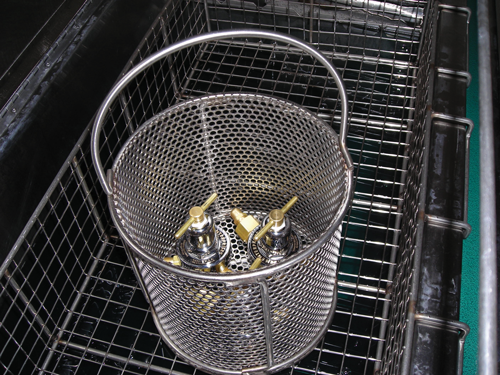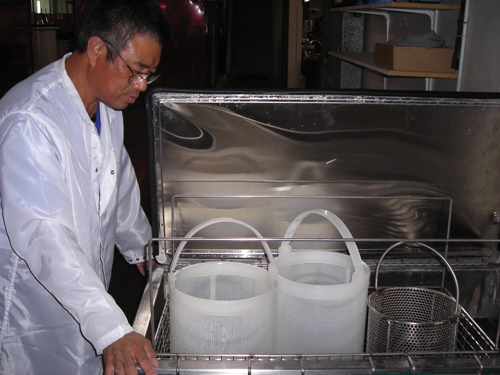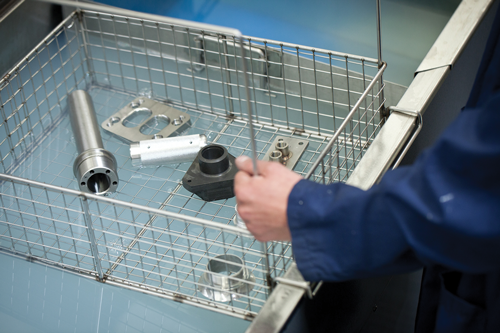Maximizing the Ultrasonic Cleaning Process
Process works best when customized to meet the needs of each application.
Numerous effective cleaning methods are available to clean flat manufactured parts with little surface complexity or those that are grossly contaminated.
But when the parts are intricate—with blind or threaded holes, various contours or deep cavities—ultrasonic cleaning sets itself apart. This process creates vacuum bubbles that clean on a microscopic level. Because the small bubbles can get into tight areas, this method stands out when used in precision cleaning.
Generally, most ultrasonic cleaners use a water-based chemistry. While prevalent in the 1970s and early 80s, solvent-based chemistries such as vapor degreasers have become less common. Because water-based chemistries have more disposal options, they tend to be more environmentally friendly to work with. However, it is important to remember that while the soap and water by themselves may be fine, the contaminants that they remove may not be so environmentally friendly.

Ultrasonic cleaning sets itself apart when it comes to intricate parts with blind holes or deep cavities.
Shops need to consider the contaminants they are removing and how best to dispose of them. A couple of different methods can be used to separate the water out and leave a smaller volume of sludge for disposal. Some systems can evaporate off the water. Alternatively, a flocculation powder can be added to the fluid to bind the contaminants. The fluid is then passed through a very thin filter to catch the heavy contaminants, allowing the remaining water to be reused. The contaminants are then allowed to harden for easy disposal.
Solvent-based cleaning, on the other hand, requires a solvent processor system, and regulations for handling and disposal are considerably more extensive. While certain applications require the cleaning capabilities of solvents, the added disposal expenses should be considered.
Correct Chemistry
Having the right chemistry is the key to any cleaning process. People often believe that ultrasonics by itself is all that is necessary, but that’s not always the case. Some applications will only require DI water to clean, but many more will require some water-based chemistry.
Frank Pedeflous, president of Omegasonics, describes the relationship between ultrasonics and chemistry in terms of hardware and software.
“The ultrasonics is the hardware, and the soap is the software,” he says. “The hardware must be matched appropriately with the software to meet the application’s needs. The wrong software (or soap) can be completely ineffective. But in the right situation, some detergents can be so effective as to mask some of the shortcomings of the ultrasonic equipment.”
A shop may purchase a cleaning system today that meets its current needs, but requirements may change over time. Often the situation can be remedied with a change in the software, or chemistry.
“One day you’re writing papers with Microsoft Word, but later you need to do some accounting or spreadsheets,” Pedeflous says. “You don’t buy a new computer; you add QuickBooks or Excel. Generally, a shop’s machining operations don’t change all that much. It’s not likely to suddenly need a cleaning system with a lot more power. If anything needs to be changed, it’s likely the chemistry.”

When purchasing an ultrasonic system, variables such as tank size, wall thickness, filtering system, temperature control and accessories should be considered.
System Selection
When shopping for an ultrasonic system, communication with an experienced supplier can make a big difference. If the supplier has previously worked with a customer on a similar application, it should have a good understanding of what type of cleaning system, process and chemistry would be most effective. If not, the supplier should be able to help figure it out through testing.
“We have a testing lab, so even if we have never cleaned a particular type of part, customers can send us parts to experiment with and find the right mix of chemistry, time and temperature,” Pedeflous says. “We can clean the parts in different batches to try different process combinations, then give them back to the customer for analysis so they can decide which parameters worked best for their needs.”
Once a supplier has tested a particular item, it can offer that knowledge to future clients. Often, it will find a successful process; sometimes it won’t. Sometimes ultrasound and water is not the best fit and solvents must be used. Sometimes ultrasonics is not the right technology at all. Pedeflous provides one example of a customer who badly wanted to use soap and water to avoid the expense of solvent disposal.
“It was a carbon steel part, and with water-based chemistries we just couldn’t keep rust from forming,” he says. “The application just wasn’t a good fit, so the customer had to go with a vapor degreasing system.”

Sometimes, varying the frequency levels between the wash and rinse tanks can improve cleaning.
Equipment Considerations
With the selection and purchase of any capital equipment, certain tools are better than others for specific applications. Ultrasonic cleaning systems are no different, and many are available on the market. Beyond knowing the application requirements, here are the main considerations for choosing an ultrasonic system that best fits a shop’s needs.
Tank Size: Larger tanks cost more money, so usually the smaller the better as long as there is enough space around the parts for the ultrasonic waves to properly penetrate and clean.
Tank Wall Thickness: Reducing the thickness of the stainless steel holding tank walls can reduce system costs, but thinner walls are more vulnerable to stress—and potential leaks—from the high frequency vibration of the transducers.
Number of Transducers: A system with fewer transducers can be initially less expensive, but more transducers provide a faster and more complete cleaning process. A system should have enough transducers to generate sufficient sound waves to reach the part(s) from all angles.
Temperature Control: Ultrasonic cleaning is generally most effective between 110°-150°F. A system that can maintain constant temperature levels in that range can provide predictable, effective results.
Circulating Filtration System: As contaminants are removed from parts, they either fall to the bottom of the tank, float around in the cleaning solution or float on top. If these free contaminants are not removed, they will eventually build up and inhibit cleaning. To extend the life of the solution and save time by reducing the frequency of change-outs, circulating filtration can be built into systems to continuously filter contaminants.
Accessories: Some accessories—such as a basket or tray to hold the parts above the floor of the tank and a tank cover to keep dust and dirt out of the solution when the system is not in use—are important parts of an effective ultrasonic cleaning system. These accessories come standard with some systems or as options with others.
Power Requirements
Finally, a shop needs to determine the level of ultrasonic power it will need to clean its parts. Shops often overspend in this area, believing they need a certain number of watts per gallon (watt density). But this measure is not a standard and will vary based on the application. Again, it comes down to knowing the application and its requirements.
Because many ultrasonic systems offer adjustable power levels, a shop may decide to purchase a system that can clean effectively at about 50-percent power for the majority of its applications. Anything stronger than this should not be necessary, but it’s a good idea to have some extra power to compensate for when the cavitation energy starts to drop off at the end of the system’s life. What many people do not realize is that as systems age, the intensity of the cavitation actually increases at first. When this happens, the power may need to be decreased to protect sensitive parts. Generally, the mean time between failure on most piezoelectric transducers is 20,000 hours, and shops can expect power levels to move up or down in increments of approximately one-third during this time frame. The variations in power are not typically noticeable by touch, but can be measured with a calibration probe.
For many applications, the change in cavitation energy is insignificant. However, those who are doing critical cleaning or are working on medical implants need to certify cleaning parameters, and therefore should keep a close eye on power levels.
Another factor that affects cavitation energy is the level of cleanliness of the solution. As water gets a bit dirtier, the dirt acts as a surfactant, promoting the cavitation of a stronger vacuum bubble. The non-critical machine shop environment may notice these power increases if they are not filtering thoroughly or changing the bath out.
The Right System
A trend that Pedeflous has observed in precision cleaning is the use of mixed frequencies during a single cleaning operation. Having the ultrasonic tank at one frequency level and the rinse tank at another produces two different modes of attack.
“A higher frequency creates a smaller vacuum bubble, which can penetrate a more precise or tighter location. But the larger bubble has more energy for more aggressive cleaning,” he says. “The higher frequency levels are often used for the final rinse.”
Pedeflous stresses that the key to successful ultrasonic cleaning is knowing the application and determining what system will do a sufficient job without overspending. The type of parts, quantity of parts, types of contaminants and expected usage all factor into choosing the right system.
“You don’t necessarily have to buy the most expensive cleaner on the market to get one that does a great job for your shop,” he says.
For more information on Omegasonics, call 800-669-8227 or visit omegasonics.com.
Related Content
Top Reasons to Switch to a Better Cleaning Fluid
Venesia Hurtubise from MicroCare says switching to the new modern cleaning fluids will have a positive impact on your cleaning process.
Read MoreCorrosion Resistance Testing for Powder Coating
Salt spray can be useful to help compare different pretreatment methods and coatings but it does not tell us much about the corrosion resistance of a part over time in the field. Powder coating expert Rodger Talbert offers insights into how to get a better idea of how to improve a part’s corrosion resistance in the real world.
Read MoreSolvent Versus Aqueous: Busting the Myths
Is aqueous cleaning “greener” than solvent cleaning? Is solvent a more effective cleaner than aqueous? These and many other questions are answered here to debunk the misconceptions that many manufacturers have held onto for years.
Read MoreRead Next
Episode 45: An Interview with Chandler Mancuso, MacDermid Envio Solutions
Chandler Mancuso, technical director with MacDermid Envio discusses updating your wastewater treatment system and implementing materials recycling solutions to increase efficiencies, control costs and reduce environmental impact.
Read MoreA ‘Clean’ Agenda Offers Unique Presentations in Chicago
The 2024 Parts Cleaning Conference, co-located with the International Manufacturing Technology Show, includes presentations by several speakers who are new to the conference and topics that have not been covered in past editions of this event.
Read MoreEducation Bringing Cleaning to Machining
Debuting new speakers and cleaning technology content during this half-day workshop co-located with IMTS 2024.
Read More






















